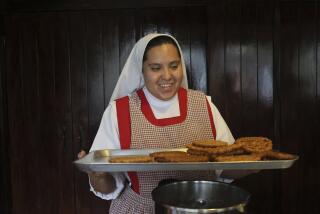Surviving Monastery : Monks Keep Faith Alive in Old Russia
- Share via
PECHORY, Soviet Union — Every day at 5:30 a.m., a strolling bell-ringer awakens 100 monks in a ritual that started nearly 500 years ago. And the black-robed monks still spend their days at work and at prayer in the ancient tradition of the Russian Orthodox Church.
Believers from miles around attend daily services at the Pskov-Pechory monastery, flocking in on holidays, challenging the state doctrine of atheism.
“The church is thriving,” the rector, Archimandrite Gabriel, said in an interview in his luxurious, art-filled quarters inside the ancient walls.
Still, the monastery is one of only seven such institutions that are still open, along with a dozen nunneries, almost 70 years after the Bolshevik Revolution. Only about 15% of the people in this part of the Soviet Union, the heart of ancient Russia, are now classified as religious believers. In czarist times, church membership was virtually universal.
Before the Bolshevik takeover, there were about 550 monasteries and 475 nunneries in Old Russia. Even as recently as 1955, there were 70 such institutions.
‘Freedom of Conscience’
The 1977 Soviet constitution provides for “freedom of conscience, that is, the right to profess or not to profess any religion, and to conduct religious worship or atheistic propaganda. Incitement of hatred or hostility on religious grounds is prohibited.”
But members of the Communist Party must profess atheism, and the state spreads anti-church propaganda in the schools. The law forbids religious instruction of groups of young people, thus banning such familiar institutions as Sunday schools.
So the rector of the monastery at Pechory regards the survival of the Russian Orthodox Church in its present form as something of a miracle. “Even the atheists are surprised,” he said. He attributes the continued church presence to “unshakable Russian faith” in a supreme being despite decades of official scoffing at “religious superstitions.”
Religious teaching of young people, he said, can be conducted in the home and at church services, where “each sermon is a lesson.” In fact, Archimandrite Gabriel said, the church might be better off if the state were less cooperative with the hierarchy.
‘Not Easy for Us Then’
“In the early 1950s, I was a seminary student and things were not easy for us then,” he said, referring to the final years of Stalinist repression.
He recalled that the Christian church thrived under persecution by the Roman authorities and only later, after it became established, were there feuds and corruption in church ranks.
“The regime (in Moscow) is now lenient, and maybe that’s not so good for the church,” he said.
The rector served his guests a sumptuous lunch, complete with red and black caviar, smoked sturgeon, pickled tomatoes and salted mushrooms, washed down with Armenian brandy.
But he pointed out that this was a holiday feast and that the next day’s meals would consist of cereal and water.
The Pechory monastery began literally underground--in caves. Hermits and holy men, seeking to isolate themselves from the world and following a precedent set by the Greek Orthodox Church, lived and worshiped in caves sometime in the 15th Century.
The first church opened in 1473, according to monastery legend, and walls were erected in 1529 to help fend off attacks by roving Teutonic knights.
With the northern border of Russia not far away, the monastery became an outpost for nearby Pskov, an ancient center of Russian culture about 160 miles southwest of Leningrad, and the monks fought as much as they prayed through hundreds of sieges and raids.
Strictly Monastic
Brother Nafanail, secretary-treasurer of the monastery and a tour guide, pointed out the 16th-Century bell tower and its carillon and said, “It heralded victory, and called monks to fight and to pray.” But after 1721, when Peter the Great defeated the Swedes in the Northern Wars, the border was pushed north and life became strictly monastic.
Now the monks spend at least four hours a day at prayer. They work another eight hours and retire every night by midnight. They produce milk, butter and cheese, and their greenhouses provide fresh flowers even in winter, along with lemons the year-round.
While there is no general rule of silence, monks are not permitted to visit one another’s cells or spend any time socializing. They do not eat meat, in order “to discourage sinful thoughts,” according to Nafanail.
The monks rarely go beyond the monastery walls. When they die, they are buried in catacombs cut from rock, where more than 10,000 have been interred over the centuries. Mass is celebrated occasionally at underground altars placed among the dead.
‘Fraternal Graves’
Visitors, guided only by candlelight, may see some coffins stacked helter-skelter in “fraternal graves” carved from the hard limestone. But most of the cave graves hold individual coffins.
The monastery is prosperous, the rector says, and gave 75,000 rubles (about $97,500) to a Soviet peace fund last year. “We simply cannot wall ourselves in from the world,” he said.
Restoration of the ancient churches is costly, but as one monk explained, “when sacrifices are needed, believers respond.”
The monastery has friends in powerful places, including the Patriarch of Moscow and all Russia, who once was rector here. The local Ministry of Transport arranges bus schedules to get believers to service on time, then return them to their homes, Nafanail said.
The gnome-like monk, with black eyes twinkling in his wrinkled face, quoted a poem of his to a visitor. It was about the monastery, which he called “a sunny corner of Old Russia . . . showing that faith still lives in this land.”
More to Read
Sign up for Essential California
The most important California stories and recommendations in your inbox every morning.
You may occasionally receive promotional content from the Los Angeles Times.













